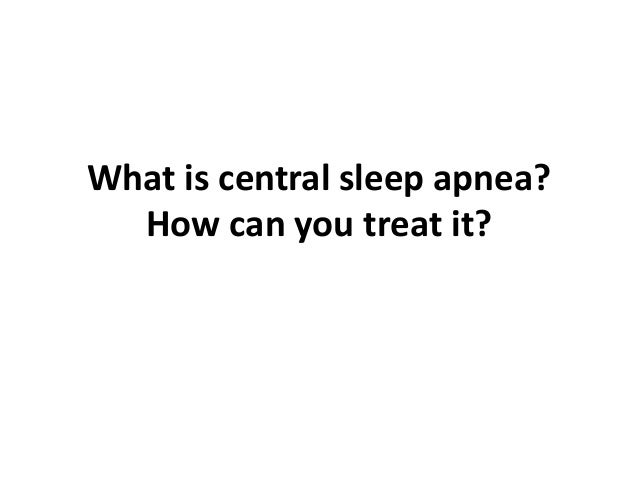What is central sleep apnea How can you treat it.pptx
•Download as PPTX, PDF•
0 likes•7 views
Central sleep apnea is a type of sleep disorder. It is a condition where your breathing starts and stops in the middle of the night. The problem results from miscommunication between the brain and body.
Report
Share
Report
Share

Recommended
Recommended
More Related Content
More from leelindesy
More from leelindesy (20)
Chillers Powering the Cooling Needs of Essential Industries.pptx

Chillers Powering the Cooling Needs of Essential Industries.pptx
Which Is Better Semi-automatic or Fully-automatic Washing Machine.pptx

Which Is Better Semi-automatic or Fully-automatic Washing Machine.pptx
Central AC vs VRF Which is the Best Cooling Solution for Your Home.pptx

Central AC vs VRF Which is the Best Cooling Solution for Your Home.pptx
What should you expect when going for a PSG test.pptx

What should you expect when going for a PSG test.pptx
Can snoring affect your relationship with your partner.pptx

Can snoring affect your relationship with your partner.pptx
Can you use your HVAC system to reduce allergy symptoms.pptx

Can you use your HVAC system to reduce allergy symptoms.pptx
What are the different types of sleep apnea tests.pptx

What are the different types of sleep apnea tests.pptx
Is your AC leaking water Here is what you can do about it!.pptx

Is your AC leaking water Here is what you can do about it!.pptx
Acute vs chronic insomnia Definition, symptom, and causes.pptx

Acute vs chronic insomnia Definition, symptom, and causes.pptx
What should you know about your air conditioner compressor.pptx

What should you know about your air conditioner compressor.pptx
How do allergies affect your good night’s sleep.pptx

How do allergies affect your good night’s sleep.pptx
Rest problems responsible for disrupting sleep in elderly people.pptx

Rest problems responsible for disrupting sleep in elderly people.pptx
Which is better A central AC or ductless air conditioning system.pptx

Which is better A central AC or ductless air conditioning system.pptx
How can you improve your quality of life if you have COPD.pptx

How can you improve your quality of life if you have COPD.pptx
What is central sleep apnea How can you treat it.pptx
- 1. What is central sleep apnea? How can you treat it?
- 2. Central sleep apnea is a type of sleep disorder. It is a condition where your breathing starts and stops in the middle of the night. The problem results from miscommunication between the brain and body. This type of sleep apnea is different from obstructive sleep apnea, in which the inhalation and exhalation process is hindered because of obstruction in the airway. For those interested in learning more about central sleep apnea and its treatments, more information is provided in the following sections. Have a look!
- 3. What is central sleep apnea? In people with central sleep apnea, the brain fails to send signals to the muscles responsible for managing the breathing process. As a result, the oxygen does not reach the lungs. The problem can result from health problems like heart failure and stroke or might affect people when they are at a high altitude. The common sleep apnea symptoms that appear in this condition are abrupt awakenings, abnormal breathing patterns, difficulty in concentrating on tasks, excessive daytime sleepiness, mood changes, and morning headaches.
- 4. How can you treat and diagnose the condition? Diagnosis: People with central sleep apnea should visit a sleep specialist if they notice the above signs. After interviewing you, he will decide on the need to evaluate your condition further. If he suspects CSA, you will be asked to undergo a polysomnography test which involves monitoring the patient overnight. During the process, some wires and equipment are connected to your heart, lungs, and brain to study their activity. Furthermore, things like breathing patterns, blood oxygen levels, and leg movements are also noted.
- 5. Treatments: The treatment options include: Addressing associated problems: Central sleep apnea results from other disorders or ailments in many people. So, going to the root cause and treating the underlying causes might help cure the condition. For example, offering therapy for heart failure can affect sleep apnea. Supplemental oxygen: One of the recommended treatments for central sleep apnea patients is supplemental oxygen. Air can be delivered to your lungs using several devices. Reduction of opioid meds: Taking certain medications leads to other health complications. This is also the case with opioid meds. If your CSA results from these meds, your doctor will ask you to reduce the dosage.
- 6. CPAP machine: Using the CPAP device involves wearing a mask around your mouth and nose when asleep. This mask is attached to a pump, ensuring continuous pressurised air delivery to keep the airway open. Adaptive servo-ventilation: If the CPAP is not proving effective in your case, you might be suggested adaptive servo-therapy. In this treatment also, pressurised air is delivered to your lungs. But, the pressure is changed breath- by-breath during inhalation to smoothen the breathing pattern. BiPAP: The bi-level positive airway pressure machine also alternates the pressure. So, the pressure is different when you breathe in, and when you breathe out, it is changed again. But, what makes it different is that, unlike ASV, with BiPAP, the pressure during inhalation is fixed. So, these are a few treatment options for people suffering from central sleep apnea.
- 7. Thank You
